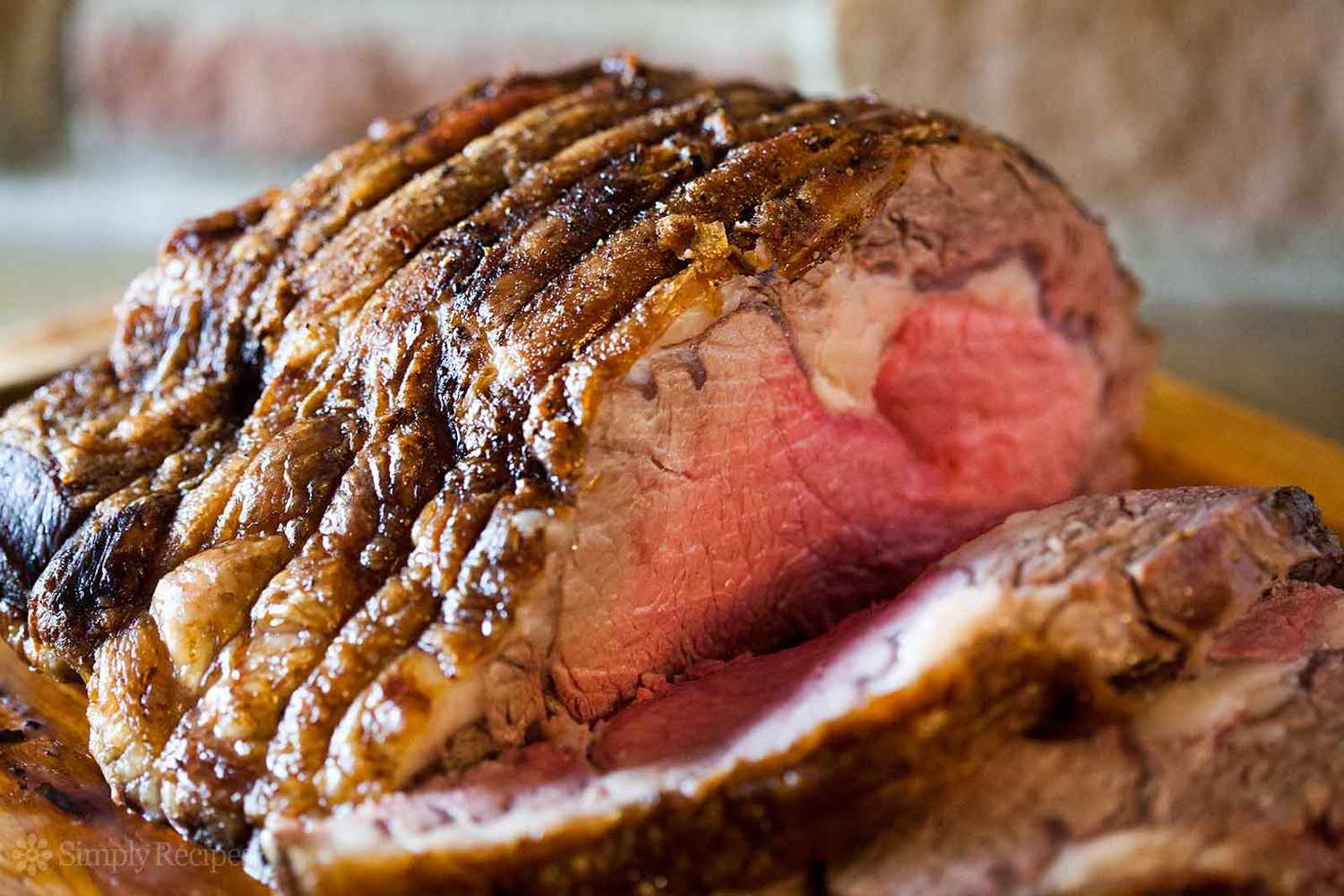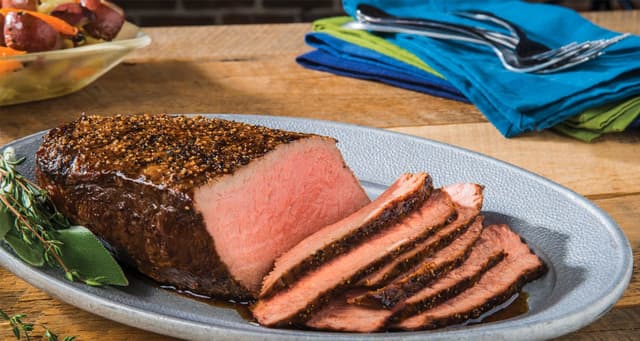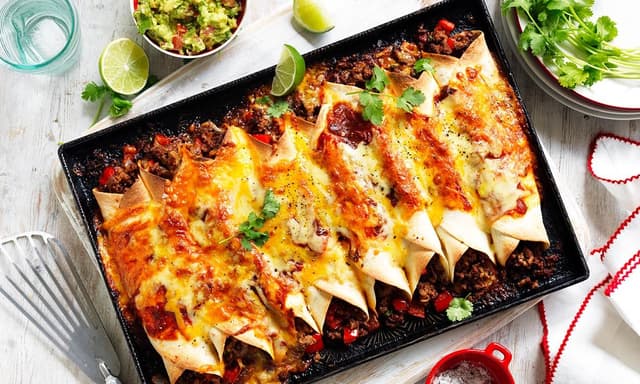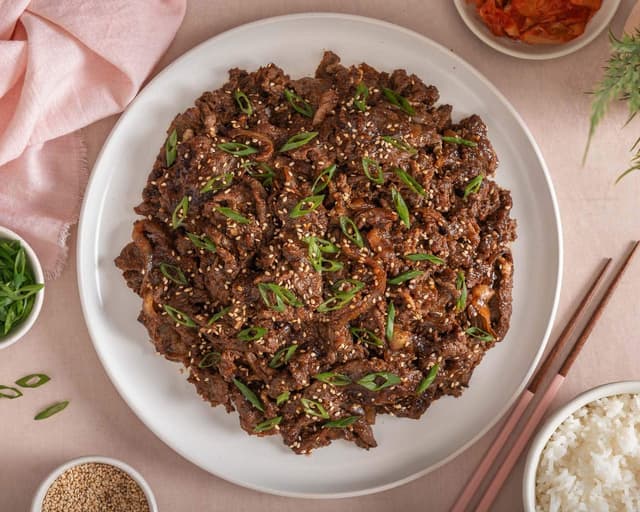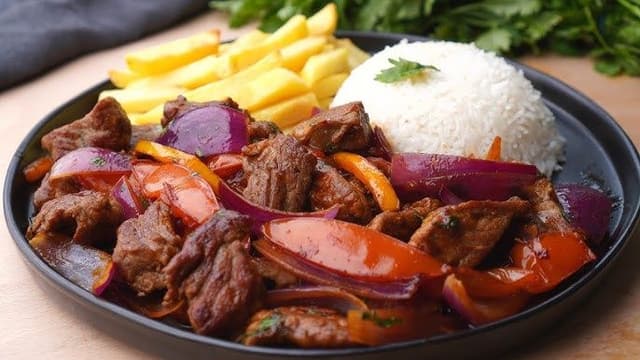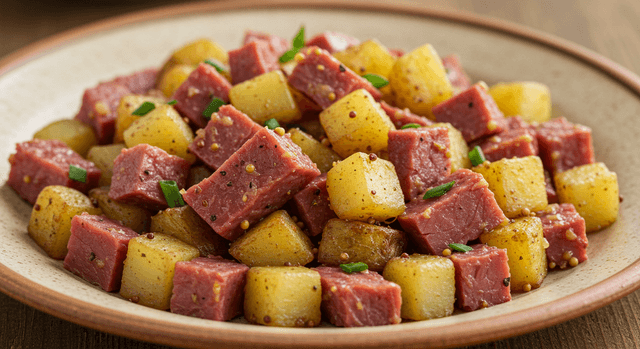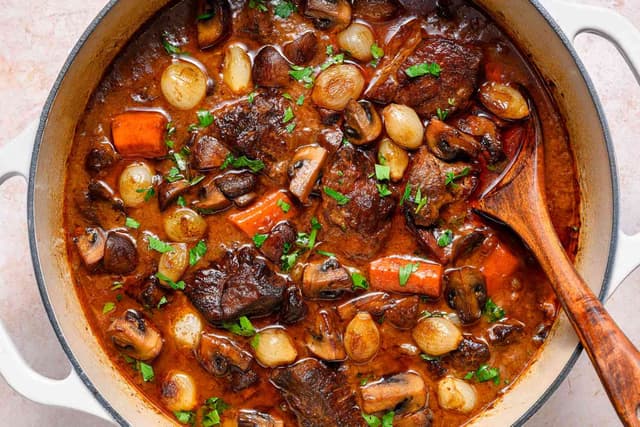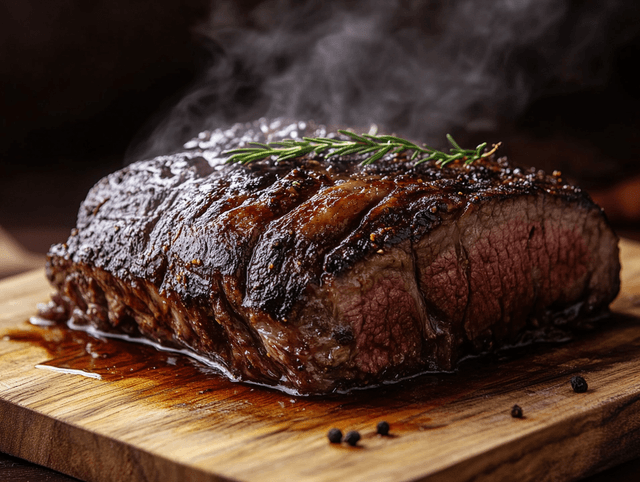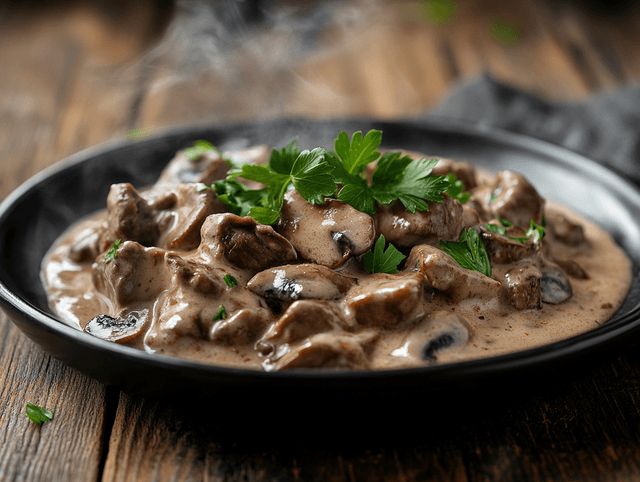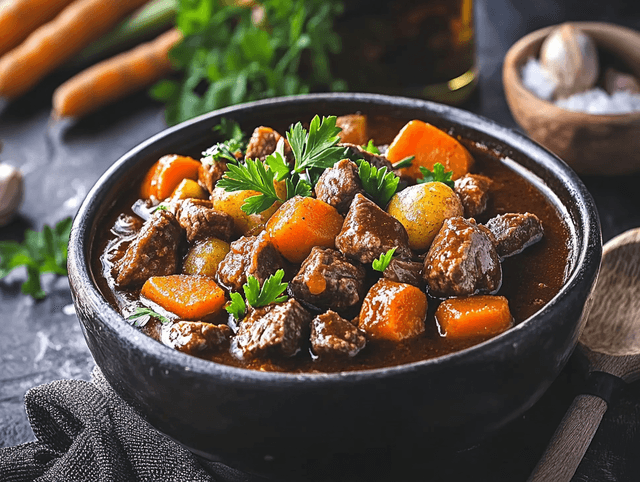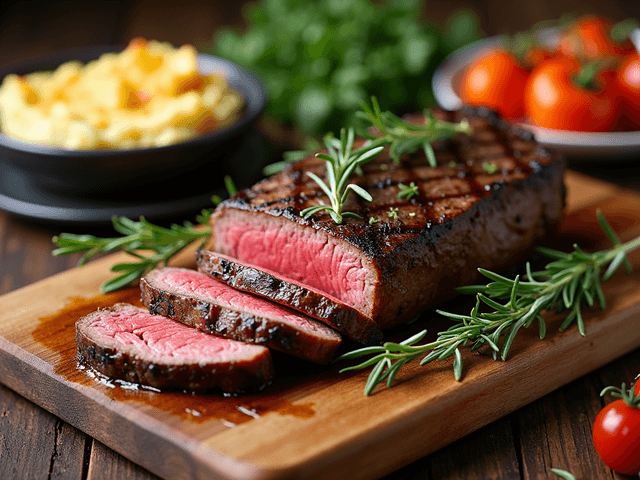Introduction
A perfectly cooked prime rib roast is more than just a meal; it is an event, a centerpiece that commands attention and promises a memorable feast. With a history stretching back to the grand banquets of British royal courts, this "king of roasts" has long been a symbol of celebration and affluence. Its signature appeal—a deep brown, crackling crust giving way to a swath of juicy, perfectly pink meat—makes it a true showstopper for any occasion.
While its majestic appearance can seem intimidating, this recipe demystifies the process, transforming a daunting challenge into a foolproof culinary triumph. By embracing a few key techniques and a measure of patience, you can confidently create a restaurant-quality masterpiece in your own kitchen, one that will become the star of your holiday table and family gatherings for years to come.
Why Make This Delicious Recipe & When to Serve It
The magic of a prime rib roast lies in its unparalleled tenderness and profound, beefy flavor. This specific cut comes from the upper rib section of the animal, an area with muscles that are not heavily used, making the meat naturally tender. Its generous intramuscular fat, or marbling, melts during the slow-cooking process, basting the meat from within to create a succulent, juicy texture that is simply unforgettable.
This roast is the quintessential dish for marking life's most important moments. It is the centerpiece of choice for Christmas and New Year's feasts, special anniversaries, and milestone birthdays. It also beautifully revives the tradition of the "Sunday Roast," a meal designed to bring the entire family together around a shared table.
Mastering this recipe is a deeply rewarding experience for any home cook. It’s an opportunity to learn core culinary principles while creating a truly impressive meal. More than that, it’s a chance to establish your own family traditions, from a signature carving ceremony at the table to passing down the secrets of the perfect herb crust for generations to come.

Basic Ingredients (Serves 8-10 people)
- 1 (8- to 9-pound) bone-in prime rib roast (4 ribs): This is the star of the show. A "prime" grade roast offers the most marbling for exceptional juiciness and flavor, though a high-quality "choice" grade will also yield delicious results.
- 3 tablespoons kosher salt: As the most critical seasoning, kosher salt not only adds flavor but is essential for the dry-brining process, which tenderizes the meat from within and ensures a perfectly crisp crust.
- 1 tablespoon coarsely ground black pepper: The classic counterpart to salt, freshly ground black pepper provides a pungent, spicy note that beautifully balances the rich beef flavor and contributes to the savory crust.
- 6-8 large cloves garlic, finely minced: Minced garlic adds a layer of aromatic, savory depth to the roast. Mincing it with a knife, rather than using a press, prevents it from burning during the high-heat searing phase.
- 2 tablespoons fresh rosemary, finely chopped: This robust, piney herb is a traditional and perfect partner for beef, infusing the fat cap with a wonderfully festive aroma as it renders during the cooking process.
- 1 tablespoon fresh thyme, finely chopped: Adding a subtle, earthy, and slightly minty note, fresh thyme complements the rosemary and garlic, adding a final layer of complexity to the classic herb crust.
- ¼ cup extra light olive oil: This acts as a binder, helping the fresh herb and garlic rub adhere to the surface of the roast. Using an oil with a high smoke point is key to preventing a smoky oven during the final sear.

Step-by-Step Preparation
- Prepare the Roast (24-48 Hours in Advance): Ask your butcher to cut the rack of bones away from the roast and then tie it back on securely with kitchen twine. This brilliant step provides the flavor-insulating benefits of bone-in cooking while making the final carving effortless. Once home, pat the entire roast dry with paper towels to prepare it for seasoning.
- Dry-Brine for Flavor and Juiciness: In a small bowl, combine the 3 tablespoons of kosher salt and 1 tablespoon of coarsely ground black pepper. Rub this mixture generously over every surface of the roast. Place it on a wire rack set inside a rimmed baking sheet and refrigerate, uncovered, for at least 24 and up to 48 hours. This dry-brining process is non-negotiable for achieving a deeply seasoned, incredibly moist roast.
- Bring to Room Temperature (Crucial for Even Cooking): Remove the roast from the refrigerator 3 to 4 hours before you plan to cook it, leaving it on the counter. Allowing such a large cut of meat to come to room temperature is essential for ensuring it cooks evenly from edge to center, which prevents a cold middle and an overcooked exterior.
- Apply the Herb Rub and Preheat: About 30 minutes before roasting, preheat your oven to a low '225∘F' ('107∘C') with a rack positioned in the lower third. In a small bowl, mix the 6-8 minced garlic cloves, 2 tablespoons of fresh rosemary, 1 tablespoon of fresh thyme, and ¼ cup of olive oil to form a thick paste. Gently pat this aromatic rub all over the fat cap and sides of the room-temperature roast.
- The Low-and-Slow Roast (The Reverse Sear Method): Place the roast, bone-side down, into a heavy-duty roasting pan; the bones will serve as a natural roasting rack. Insert an oven-safe probe thermometer horizontally into the thickest part of the meat, making sure the tip doesn't touch any bone. Roast until the internal temperature reaches '120−125∘F' for a perfect medium-rare. Trust the thermometer, not the clock, as this can take 3.5 to 4.5 hours.
- Rest the Roast (The Most Important Step): Once the target temperature is reached, remove the roast from the oven and transfer it to a large cutting board. Tent it loosely with aluminum foil and let it rest for a minimum of 30 minutes and up to an hour. During this critical rest, carryover cooking will raise the internal temperature by '5−10∘F', and the juices will redistribute throughout the meat, ensuring every single slice is succulent.
- The Final, High-Heat Sear: About 15 minutes before you are ready to serve, adjust the oven rack to the middle position and increase the temperature to its highest setting, typically '500−550∘F' ('260−288∘C'). Remove the foil and return the rested roast to the blistering-hot oven for 6 to 10 minutes, just until a magnificent, deep-brown, and sizzling crust has formed. This final blast of heat creates an irresistible texture without overcooking the perfectly rosy interior.

Tips for the Perfect Recipe
- Invest in a Thermometer: This is the single most important tool for success. An in-oven probe thermometer removes all guesswork during the long roast, while a quality instant-read thermometer is perfect for a final, accurate check. Do not rely on time-per-pound estimates.
- Embrace the Dry-Brine: Do not skip the step of salting the roast and letting it rest uncovered in the fridge for at least one day. This is the professional secret to a roast that is seasoned to its core and has an exceptionally dry surface, which is essential for creating a perfectly crisp final crust.
- Bone-In is Better: The bones serve as a natural roasting rack, but more importantly, they act as an insulator. This slows the cooking of the meat nearest to them, leaving that section extra-tender and juicy while protecting the rest of the roast from overcooking.
- Don't Fear the Fat: A prime rib is defined by its generous fat cap and beautiful marbling. This fat is the source of its incredible flavor and moisture. You should trim any hard gristle or fat that is thicker than one inch, but be sure to leave a solid ¼-inch layer to baste the meat as it cooks.
- Rest is Not Optional: Slicing into a roast immediately after it comes out of the oven will cause all its flavorful juices to spill onto the cutting board. Resting the meat for at least 30 minutes allows those juices to be reabsorbed by the muscle fibers, guaranteeing a moist and succulent result every time.

Serving Ideas
- The Art of Carving: After the final sear, place the roast on a large cutting board. Snip the kitchen twine and simply lift off the entire bone rack. These bones, with their delicious, crispy meat, can be served alongside the roast for guests to enjoy. Turn the boneless roast and identify the direction of the grain (the muscle fibers), then position your knife to slice against the grain for maximum tenderness. Using a long, sharp carving knife, cut the roast into your desired thickness—classic slices are about ½ to ¾ of an inch thick. Use long, smooth strokes rather than a sawing motion for clean, beautiful slices.
- Classic Side Dishes:
- Potatoes: The quintessential partner for prime rib. Offer creamy Roasted Garlic Mashed Potatoes, elegant Potatoes Au Gratin with layers of cheese and cream , or individual Twice-Baked Potatoes loaded with sour cream and chives.
- Yorkshire Pudding: A time-honored British tradition for a reason. These light, savory, and puffy popovers are the perfect vessel for soaking up the rich pan drippings or a flavorful au jus.
- Roasted Vegetables: Balance the decadent richness of the meat with vibrant, earthy vegetables. Roasted Brussels Sprouts with Bacon, Honey-Glazed Carrots, or simple Roasted Asparagus with Lemon and Parmesan are all excellent and complementary choices.
- Essential Sauces:
- Au Jus: Use the flavorful drippings left in the roasting pan to create a simple, classic au jus. This natural sauce enhances the beefy flavor of the roast without overpowering it.
- Creamy Horseradish Sauce: The sharp, pungent kick of horseradish suspended in a cool, creamy base provides the perfect, classic contrast to the rich, fatty beef, cleansing the palate with each bite.

Tips for Storing and Reheating
Storing Leftovers
- Wrap Tightly: Once the roast has cooled completely, wrap any leftovers tightly in plastic wrap or place them in an airtight container. This is crucial for preventing the meat from drying out or absorbing other odors from the refrigerator.
- Store Whole: For the best results and maximum moisture retention, store the leftover roast in a large, unsliced piece rather than in individual slices. You can slice it just before reheating and serving.
- Refrigerate or Freeze: Properly stored leftovers will keep for 3 to 5 days in the refrigerator. For longer-term storage, the roast can be frozen for up to six months. When freezing, consider drizzling it with a little beef broth or au jus before wrapping to add extra moisture upon thawing.
Reheating Tips
- Go Low and Slow: The best way to reheat prime rib without compromising its texture is to do it gently in a low oven. Preheat your oven to a moderate '300∘F' ('150∘C').
- Add Moisture: Place the sliced or whole leftover prime rib in a baking dish and add a splash of beef broth or leftover au jus. This creates a steamy environment that gently heats the meat while keeping it tender and moist.
- Cover and Heat: Cover the dish tightly with foil and place it in the preheated oven for 15 to 30 minutes, depending on the size and thickness of the meat, until it is just warmed through. Avoid using a microwave if possible, as its harsh heat can make the meat tough, dry, and gray.
Conclusion
This foolproof prime rib recipe elevates a seemingly daunting endeavor into a triumphant and delicious culinary achievement. By trusting in the science of slow-roasting, the precision of a thermometer, and the art of patience, you can confidently present a spectacular centerpiece that is rich in history, bursting with flavor, and guaranteed to create unforgettable memories around your table.
Frequently Asked Questions
Q: How much prime rib should I buy per person?
A: A reliable rule of thumb is to plan for one pound of bone-in roast per person. This generous estimate accounts for the weight of the bones and fat, ensuring every guest receives a hearty serving with the welcome possibility of leftovers.
Q: What's the difference between "Prime" and "Choice" grade beef?
The USDA grade primarily reflects the amount of intramuscular fat, known as marbling. "Prime" is the highest grade, featuring the most marbling, which results in the juiciest and most flavorful meat. "Choice" is the next grade down and is still an excellent, widely available option.
Q: Some of my guests like their steak more well-done. What should I do?
A: Cook the entire roast to a perfect medium-rare to preserve its integrity. For guests who prefer their meat cooked further, you can place their individual slices in a hot skillet with a little simmering au jus for 15-30 seconds per side until they reach the desired doneness.
Q: Is it really necessary to season the roast a day or two in advance?
A: Yes, this step, known as dry-brining, is absolutely critical for the best results. Salting the roast well in advance allows the salt to slowly penetrate deep into the muscle, seasoning it thoroughly from within and helping it retain more moisture during cooking for a juicier final product.
Works cited
- windsorqualitymeats.com, accessed July 4, 2025, https://windsorqualitymeats.com/history-of-prime-rib-from-royal-tables-to-modern-kitchens/#:~:text=The%20origins%20of%20prime%20rib,encompassing%20ribs%20six%20through%20twelve.
- History Of Prime Rib: From Royal Tables To Modern Kitchens ..., accessed July 4, 2025, https://windsorqualitymeats.com/history-of-prime-rib-from-royal-tables-to-modern-kitchens/
- 13 Rules For Perfect Prime Rib | The Food Lab - Serious Eats, accessed July 4, 2025, https://www.seriouseats.com/how-to-make-perfect-prime-rib-for-christmas-dinner
- Why Prime Rib at Christmas? - Tony's Meats & Market, accessed July 4, 2025, https://tonysmarket.com/why-prime-rib-at-christmas/
- National Prime Rib Day – April 27, 2026, accessed July 4, 2025, https://nationaltoday.com/national-prime-rib-day/
- Your New, New Year's Tradition: Prime Rib Roast - The Art of Manliness, accessed July 4, 2025, https://www.artofmanliness.com/living/food-drink/how-to-make-prime-rib/
- History of The Prime Rib - Remingtons Signature Dish, accessed July 4, 2025, https://www.remingtonsofniagara.com/blog/articles/2017/02/25/prime-rib-history
- The Prime Rib Christmas Tradition Explained, accessed July 4, 2025, https://dlightfuldishesmo.com/2024/12/25/the-prime-rib-christmas-tradition-explained/
- Everything to Know About Prime Rib - Food Network, accessed July 4, 2025, https://www.foodnetwork.com/how-to/packages/food-network-essentials/everything-to-know-about-prime-rib
- Ask the Expert: What Are the Secrets to Cooking a Delicious Rib Roast?, accessed July 4, 2025, https://mvmagazine.com/news/2022/12/20/ask-expert-what-are-secrets-cooking-delicious-rib-roast
- 3-Ingredient Prime Rib: The Easiest Way to Make a Delicious Roast, accessed July 4, 2025, https://nomnompaleo.com/prime-rib
- Prime Rib Recipe (VIDEO) - NatashasKitchen.com, accessed July 4, 2025, https://natashaskitchen.com/prime-rib-recipe/
- Easy Prime Rib Roast Recipe - Allrecipes, accessed July 4, 2025, https://www.allrecipes.com/recipe/240543/easy-prime-rib-roast/
- Roasted and Reverse Seared Prime Rib Recipe - Serious Eats, accessed July 4, 2025, https://www.seriouseats.com/perfect-prime-rib-beef-recipe
- Prime Rib Cooking Times & Guide - Traeger Grills, accessed July 4, 2025, https://www.traeger.com/learn/how-to-cook-prime-rib
- How to Cook Perfect Prime Rib Roast - ThermoWorks Blog, accessed July 4, 2025, https://blog.thermoworks.com/science-of-perfect-prime-rib-roast/
- Carving Prime Rib Roast - Martha Stewart Cooking School - YouTube, accessed July 4, 2025, https://www.youtube.com/watch?v=JTC_zTR5AMw
- How to Expertly Carve a Standing Rib Roast - wikiHow, accessed July 4, 2025, https://www.wikihow.com/Carve-a-Standing-Rib-Roast
- How to Carve a Prime Rib Roast - YouTube, accessed July 4, 2025, https://www.youtube.com/watch?v=cOgWGNf5St4
- How to Carve Prime Rib | F.N. Sharp, accessed July 4, 2025, https://fnsharp.com/blogs/fns/how-to-carve-prime-rib
- 30 Best Prime Rib Side Dishes to Pair With Your Roast - The Pioneer Woman, accessed July 4, 2025, https://www.thepioneerwoman.com/food-cooking/meals-menus/g37973381/side-dishes-for-prime-rib/
- What to Serve With Prime Rib - Traeger Grills, accessed July 4, 2025, https://www.traeger.com/learn/what-to-serve-prime-rib
- 27 Prime Rib Sides That Will Make Your Main Dish Shine - Delish, accessed July 4, 2025, https://www.delish.com/holiday-recipes/christmas/g29371479/side-dishes-for-prime-rib/
- First time making a full Prime Rib roast any tips/tricks? : r/meat - Reddit, accessed July 4, 2025, https://www.reddit.com/r/meat/comments/1gvzoem/first_time_making_a_full_prime_rib_roast_any/
- The Right Way to Reheat for the Juiciest Prime Rib - Allrecipes, accessed July 4, 2025, https://www.allrecipes.com/article/pro-tips-on-how-to-reheat-prime-rib/
- How to Reheat Prime Rib So It Stays Juicy (Plus 3 Ways to Never Reheat The Meat), accessed July 4, 2025, https://www.bhg.com/how-to-reheat-prime-rib-8598885
- What to Do with Leftover Prime Rib - Snake River Farms, accessed July 4, 2025, https://snakeriverfarms.com/blogs/srf-journal/what-to-do-with-leftover-prime-rib
- lawrys.id, accessed July 4, 2025, https://lawrys.id/blog/how-to-reheat-a-prime-rib/#:~:text=FAQ-,What's%20the%20best%20way%20to%20reheat%20prime%20rib%20without%20drying,reheating%20at%20a%20moderate%20temperature.
- How to Buy and Cook Prime Rib | The Food Lab - Serious Eats, accessed July 4, 2025, https://www.seriouseats.com/food-lab-guide-to-prime-rib
- How can I best accommodate someone preferring well done prime rib? The rest of us want med-rare. - Reddit, accessed July 4, 2025, https://www.reddit.com/r/AskCulinary/comments/zu4p6t/how_can_i_best_accommodate_someone_preferring/
